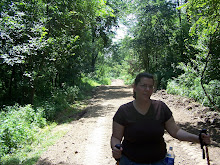The story of the three little pigs has been told to death. As children we hear it over and over so frequently that most children can recite the lines "not by the hair of my chinny-chin-chin". We all know the story of the three brother pigs who build houses to see them knocked down. The original story had them eaten. The Disney version had the brothers surviving the attacks. And perhaps it is because we are so familiar with the tale that we are so comfortable parodying it.
The first time I read The True Story of the Three Little Pigs I was amazed at how easy it was to deconstruct the story into something new. But not even that innovative story had prepared me for David Wiesner's The Three Pigs. I had heard that the book was revolutionary. I had heard that it turned the story on its head but when I finally sat down and read it I was blown away. (pun intended) Wiesner (whose work I adore) is a genius. This book might have to be the most unique I've read in a while.
Warning: spoilers. If you have not read this book stop right here. Head to the library and pick up a copy. After you are done come back. Otherwise, I might just spoil the greatest children's literary surprise in years.

The story starts out in the traditional fashion with the pigs and their houses. But when the pig in the straw house is blown out of the frame, the story becomes something entirely new. The three pigs manage to escape the wolf by stepping out of the story and adventuring on their own. I love how they use the dangerous wolf as a paper airplane to set out on their trip. They make a mess of the linear story panels, head butting them and scattering them. They wander into other tales, picking up stray characters on the way. I love the transitions they make between story character and outside characters. In one story, they become black and white illustrations while helping a dragon escape from the knight who intends to slaughter it. As they, and the dragon, leave the story panel they become colored again.
I was enchanted with how Wiesner plays with the traditional story. The wolf is confused as the narration tells him that he eats the pig up, yet clearly there is no pig to be eaten. The knight is similarly unsure when the dragon he was sent to kill is gone. The narration continues as normal but the characters are simply missing. When the pigs, plus cat (from Hey Diddle Diddle) and dragon, decide to go home they simply rearrange the panels and arrive back at the house of bricks. And everyone, except the wolf, lives happily ever after.
The visual work on this book is incredible. Wiesner creates different looks for the different tales and manages to slip his characters in. Children will love recognizing the pigs in each of their different versions. Once the characters slip out of the story frame they become more lifelike. What used to be a pig outline, is suddenly covered with fur and color. What used to be a black and white dragon, is now a multicolored scaly beast. We get the idea that these characters are much more themselves when not confined to their designated script. The place outside of the stories is all white, which for me symbolized the idea of a blank slate. That anything could happen. And certainly as we see the pigs say "lets explore this place" and take off in their wolf designed paper airplane, we feel the freedom that an unlimited adventure can contain.
I can't recommend this book highly enough. Children and adults will both be enchanted with the unique story and the innovative drawings. Wiesner has outdone himself. It is no surprise to me that this book won the Caldecott.

No comments:
Post a Comment